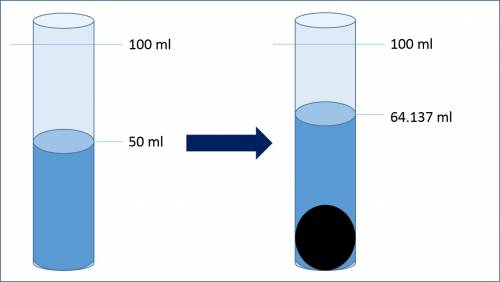Assuming the marble has an spherical shape, its volume can be calculated by the following formula:
where  is the radius of the sphere and also is the half of its diameter
is the radius of the sphere and also is the half of its diameter  :
:
Now, if we know the diameter of the black marble is  , its radius is:
, its radius is:
Substituting this value on equation (1):
Simplifying:
 >>>>>This is an approximation of the volume of the marble
>>>>>This is an approximation of the volume of the marble
Note that  , therefore the result above can be also written as
, therefore the result above can be also written as 
According to the Archimedes’ Principle a body totally or partially immersed in a fluid at rest, experiences a vertical upward thrust equal to the mass weight of the body volume that is displaced.
In this case, if we have a graduated cylinder with the capacity to contain 100 ml of water, and we fill it with 50 ml of water (as shown in the image attached) and then we add the black marble until it sinks; the water level will increase according to the principle explained above.
As the marble does not absorb water, the space it occupies displaces the water upwards and, in this way, it is possible to determine its volume or the final volume the water level indicates in the cylinder.
We already know the initial volume of water  in the graduated cylinder, which is 50 ml, and we know the volume of the marble
in the graduated cylinder, which is 50 ml, and we know the volume of the marble  because we calculated it above. If we want to know the final volume of water level
because we calculated it above. If we want to know the final volume of water level  we have to use the following relation:
we have to use the following relation:
Finally:
 >>>>>This is the final volume of the water level indicated in the graduated cylinder
>>>>>This is the final volume of the water level indicated in the graduated cylinder
